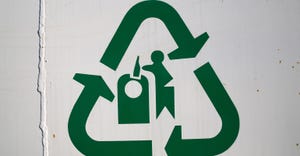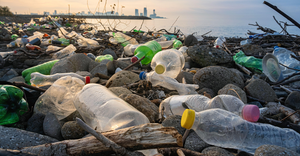March 1, 2004
Keith Matteson, Kevin Kluzak and Dean Starook
EVEN IF IT MAY BE PROPER etiquette and environmentally mandated, controlling landfill methane gas is not always an easy thing to do. As the city of Norfolk, Va., recently discovered, navigating all of the legal, financial and environmental factors can be challenging, especially when you are dealing with a pre-Subtitle D facility and privately owned property.
In the mid-1990s, after installing a landfill gas (LFG) monitoring probe network at its Campostella Landfill, the city noticed methane concentrations above regulatory levels were migrating offsite. Both the city and an adjacent private property owner had placed waste on both sides of the landfill's property boundary. Consequently, conventional remediation methods alone, such as using an active extraction system or passive cut-off trench on the city's property, would not eliminate the methane.
To control the potential risks and liabilities associated with the landfill, the city attempted to purchase the adjacent property. This would have been one option that would have allowed Norfolk to properly address permitting, regulatory responsibility, liability, communication and issues related to managing the waste and any offsite LFG migration.
Negotiations with the landowner were not successful. Nevertheless, the city worked with the Virginia Department of Environmental Quality (DEQ) to amend the landfill's solid waste management permit so that the city could access the private property to manage the gas — without having to buy the property.
Filling 'Er Up
Norfolk's Campostella Landfill is a 50-acre site that was operated for area residents from 1944 until 1992. Just north of the Norfolk-Chesapeake city line and approximately 2,500 feet south of the eastern branch of the Elizabeth River, the site is bordered to the east by Ingram Auto Mall, an active automobile junkyard. A Norfolk Southern Railroad right-of-way lies to the south. Beyond the railroad right-of-way is residential housing. A tidal marsh tributary and properties that have been used for industrial and commercial uses, primarily automobile junkyards, are located north of the landfill. Prior to being used as a municipal dump, the property's eastern portion consisted of low lying undeveloped land with a third tributary of Steamboat Creek running through the site's center. The site's western portion consisted of a World War II-era housing complex called Anderson Park.
No records describe the type of materials that were initially disposed of at the dump. However, field investigations indicate that the eastern portion of the site primarily received municipal solid waste (MSW) until the early 1980s. The northeastern portion of the fill area was closed before Resource Conservation and Recovery Act (RCRA) regulations were established in December 1988. Up to 30 feet of dredge material also was placed on top of the MSW before the northeast area was closed. The cap system on the southeast section, installed in the early 1990s, included a flexible membrane liner (fml). The western area was permitted in 1983 to receive construction and demolition (C&D) debris, then was closed in the mid-1990s.
Historical aerial photographs indicate filling began in the southeastern corner of the facility and progressed toward the northeast. No base excavation appears to have been performed to prepare for waste disposal. The adjacent Ingram Auto Mall property was filled in between 1963 and 1980, reportedly by both the city and the property owner. Approximately 30 feet or more of waste and cover soil exists on the boundary of the landfill and Ingram property. By 1980, most of the landfill base area and creek beds were full, and the Ingram Auto Mall property had reached the current elevations. By the early 1990s, the landfill reached its current elevations and aerial extent.
Landfill Gas Problems
As the landfill was being closed in the mid-1990s, a network of LFG monitoring probes was installed on the site's perimeter to meet Virginia solid waste management regulations (VSWMRs) and to determine whether methane in the subsurface was leaving the site at concentrations above the lower explosive limit (LEL). Monitoring indicated that, indeed, methane concentrations were significantly above the LEL of 5 percent methane gas by volume in probes along the site's northeastern boundary.
The probes were installed in dredge material that overlies MSW in that section of the site. Investigations also indicated that buried MSW extended well beyond the landfill property boundary onto the Ingram property north of the facility. Methane levels above the LEL also were detected in temporary monitoring probes on the railroad right-of-way adjacent to the Ingram property.
It was impossible for the city to remediate the probes at the landfill's northeast property boundary with its existing permit. So, the city began negotiating with the adjacent property owner to purchase the land. But legal and financial factors, and the potential environmental liability at the property not related to landfilling operations, hindered negotiations to purchase the land for a reasonable price. This left the city in an awkward position: Norfolk could not control the property without accepting responsibility for potential environmental liabilities that it was not party to.
Permit Amendments
To address the methane level exceedances in the monitoring probes along the landfill's northeastern boundary with the Ingram property, Norfolk asked the VDEQ to revise the gas compliance boundary to encompass the Ingram land and additional smaller parcels owned by others — without moving the facility property boundary. The new gas compliance boundary would include property not owned by the city and would be moved by amending the landfill's permit. Also, the city wanted permission to manage methane migration from the Ingram site onto the railroad right-of-way by installing a passive gas cut-off wall in affected areas.
Before the proposed solution could be implemented, the city needed to address the VSWMRs and VDEQ concerns. This included demonstrating the city was able to monitor methane levels on the Ingram site, notify all property owners within the revised gas compliance boundary and demonstrate “legal control” of the adjacent property.
The city and the adjacent property owner developed a right of entry agreement to allow it to monitor the adjacent property. With the agreement, the city could:
Undertake any remedial actions required to address LFG migration within the Ingram property.
Access the Ingram property at any time to check both existing monitoring probes and the interior of structures within the LFG compliance boundary for the presence of methane.
Undertake any other actions required by the DEQ.
Right of entry agreements with additional property owners were not required because monitoring probes were not installed on their lands and because the sites did not contain enclosed structures. The city notified all property owners of the revised gas compliance boundary using a certified letter that described the proposed change to the gas compliance boundary as well as potential LFG risks.
To ensure future structures built on the properties would address LFG concerns, the city flagged the properties in its building code enforcement database so that additional safety requirements could be included in designs.
Norfolk demonstrated it had legal control of the property partly by quoting the city charter that states that the city could obtain the property through eminent domain. VDEQ considered this, in addition to the right of entry agreement, to be adequate legal control of the property. However, the DEQ indicated that if property conditions are warranted, actual physical control by the city may be required by exercising eminent domain powers.
The city addressed gas migration onto the railroad right-of — way by installing a passive gas trench. The trench reduced methane levels to below regulatory limits outboard of the trench within approximately six months. If methane levels do not remain below regulatory limits, the facility's permit amendment requires additional remedial measures be implemented, such as converting the passive trench to active use. This would involve installing one or more blowers and associated piping, and connecting them to the existing trench vent risers.
Methane levels in enclosed structures within the revised gas compliance boundary now are monitored using internal methane detectors that incorporate external visual annunciation (e.g. flashing lights). Because one structure is commonly staffed, the monitoring system in this building also incorporates remote wireless dial-out capability. One structure was not monitored because it is elevated and prefabricated, which provides sufficient ventilation. Two structures within the revised gas compliance boundary are three sided, and so do not require monitoring because fresh air vents the buildings.
Based on its negotiations, Norfolk formed a partnership with the DEQ. But more importantly, the city developed a solution to LFG migration at the Campostella Landfill that:
Was practical and cost effective to implement;
Complied with the Virginia solid waste management regulations;
Protects human health; and
Could be implemented in a timely manner.
Keith Matteson is with SCS Engineers in Norfolk, Va. Kevin Kluzak is with the city of Norfolk. Dean Starook is with the VDEQ in Richmond.
You May Also Like


